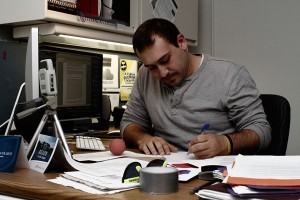From writing a story about fishing to photographing an imaginary conversation between a Bible and a Torah, Ithaca College alumni and students are coming together to share writing and photography that not only proves a picture is worth 1,000 words, but also that 1,000 words is worth a picture.

The Ten Three Project, a website that features the collaborative work of alumni and student writers and photographers, was created by Rob Engelsman ’11, current multimedia content coordinator for the college, and Amy Ginsberg ’11, earlier this year. The site was launched Nov. 7, and currently about 20 alumni, with some current students, contribute to the project.
Content on The Ten Three is broken into three categories: the “Open,” the “Turn” and the “Flip.” In an Open, writers take a photo and write exactly 1,000 words about it. In a Turn, a photographer provides a writer with a photo, which the writer has never seen and has no context for. The writer must use the photo as inspiration to create a 1,000-word story or essay. In a Flip, a writer initially writes a 1,000-word piece, which is passed off to a photographer who tries to match it with a photo.
Engelsman said he wants the project not only to explore how photos and words reflect each other, but also to tighten the community of recent college alumni. He said he hopes the website will act as a forum for the college’s creativity to become more visible.
“A collaboration is what I wanted to create so that [the college’s graduates] could work together and try new things,” he said. “One of the struggles for some of the young writers and photographers is getting clips and getting notices and getting posts places where you can get noticed.”
Colleen Cunha, a junior cinema and photography major, originally met Engelsman through a friend and was asked to contribute to the site. To date, she has participated in both a Turn and a Flip. For the Turn, she sent in a picture from an abandoned army base, and Seth Palmer ’11 wrote a story about returning to his childhood home.
Cunha said she sees the project as a play on perspective and, for her, the exciting part is interpreting someone else’s frame of view or seeing what other people get out of her work.
“It’s interesting to find what other people see in my photos,” Cunha said. “I do a lot of vague photography, like the picture I sent in last time — it was literally just a door, so [the writer] couldn’t have known it was from an abandoned barrack at an Air Force base that hasn’t been used for 50 years.”
Cunha said the posts that come from the collaborations relate in ways she would not have initially imagined. She said the project has completely changed the way she thinks about photography and has caused her to question what her audience sees in her work, as opposed to what she initially imagines when she takes the photo.
“I know that when I read the essay about my photo, it wasn’t what I was thinking, because I know what it really is,” Cunha said. “But it’s interesting to see what people get out of my work. I’m definitely more aware of myself artistically and what I’m actually doing since we talked about the project. It’s so intense.”
Palmer, who met Engelsman during their time at the college, has participated in both a Turn and an Open. In the Open, he wrote about a photo he had taken of a bridge. He said this process was more familiar to him than the Flip he wrote about Cunha’s photo.
“It’s kind of like going into your memory and taking everything that you associate with one particular instance, and you sort of drag out all of the thoughts and emotions and experiences that you associate with that,” he said. “Then you put it in writing, which is kind of strange because you normally don’t verbalize things like that.”
Michelle Bizon ’11, participated in a Flip and wrote a story that will soon be given to a photographer. She said she doesn’t have specific expectations as to how the picture will turn out.
“I’m looking forward to seeing what they come up with, because at least the photographers that I know of are great photographers and really creative people,” Bizon said. “So they could totally just do anything with it.”
Engelsman said right now all participants working with The Ten Three are people he’s brought into the fold from his own experiences at the college. He said his hope is for the project to gain more contributors and develop a base readership.
Cunha said she thinks the project succeeds in capturing the relationship between image and text.
“A picture’s worth a thousand words,” she said. “But those thousand words are never going to be the same to anyone.”
To learn more about the project, visit thetenthree.com.




